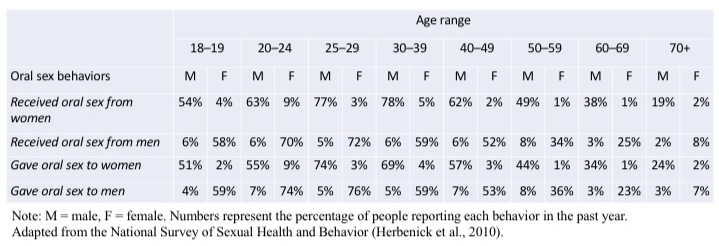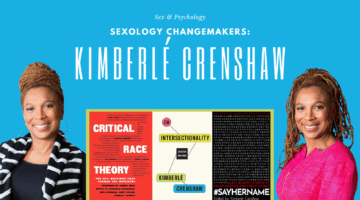The Truth About the “Oral Sex Gap”
May 3, 2019 by Justin Lehmiller
According to countless popular media articles, there is a massive disparity between heterosexual men and women when it comes to giving oral sex. Some of these articles suggest that, in male-female sexual encounters, “blowjobs are basically a given” while cunnilingus is “one of the least-often performed sex acts.” In other words, men are getting oral all the time from women, whereas women are almost never receiving it from men—a situation that has been dubbed the “oral sex gap.”
However, I did some digging into the prevalence of oral sex across genders and it turns out that these claims don’t quite match up with what the research says. The oral sex gap isn’t exactly what we have been led to believe.
Before we get into what the numbers say, I should mention that many of the media articles lamenting the “oral sex gap” cite the same study published in the Canadian Journal of Human Sexuality. They claim this study shows that “women are twice as likely to go down on their partners than men” [1].
This claim has been repeated in multiple articles and, undoubtedly, it sounds like a big gap—however, that’s not what this research actually found. In fact, in this study (which focused on heterosexual, Canadian college students), a majority of both women (59%) and men (52%) reported giving oral sex during their most recent sexual encounter. In other words, women were more likely to report giving oral than men, but it’s nowhere near the size of the difference claimed in the popular media.
So where did that erroneous claim come from? I suspect it’s because the authors of those media articles honed in on another finding from this study, which is that while 10% of men said they gave but didn’t receive oral the last time they had sex, 26% of women said the same thing. So women were more than twice as likely to give but not receive oral compared to men—however, that’s not the same as saying that “women are twice as likely to go down on their partners than men.”
While this study does suggest the presence of at least a moderately-sized oral sex gap, we should avoid drawing too many conclusions from a single study of college students. So let’s take a look at data from a nationally representative U.S. sex survey, the National Survey of Sexual Health and Behavior [2].
In the table below, you can see the prevalence of oral sex behaviors in the past year separately for men and women in different age ranges.

Let me first call your attention to the 18-19 and 20-24 year old groups. As you can see, a majority of men (51-55%) reported giving oral sex to women, but more women (59-74%) reported giving oral sex to men. That’s consistent with the results of the aforementioned Canadian college student study, suggesting that, while most men and women are giving oral to their partners, there is a gender difference in the overall odds of giving oral sex. Interestingly, though, women in this age group were also more likely than men to report having received oral sex from a partner of another gender..
When you look at age 30 and beyond, there’s an interesting reversal in the pattern—men were consistently more likely to report giving oral to women than women were to report giving oral to men. That difference seemed to get larger with age, too. In the 70+ category, men were actually more than three times as likely to say they performed oral on a partner of another gender compared to women.
I should also mention that in the 30+ age categories, men weren’t just more likely to report giving oral sex to women—they were also more likely to report receiving it.
One other thing worth pointing out is that, for all age groups under 50, a majority of men and women report having both given and received oral in the last year with a different-sex partner. In other words, most adults say they both give and receive when it comes to oral, which means it isn’t accurate to assert that oral sex is exclusively or predominately a one-way street in male-female sexual encounters.
What I hope you see from this is that the so-called “oral sex gap” isn’t exactly what it has been claimed to be. When you look beyond the distorted statistics and studies of college students, you see that the picture is far more complex—and depending on how you slice the data, you could potentially argue for very different kinds of “oral sex gaps.” For example, among college-age adults, women are more likely than men to report giving oral sex, whereas among older adults, men are more likely to report giving oral sex than women.
So where do these gaps come from? Are some more important than others? Does a gender difference in prevalence of a given sexual behavior necessarily equate to a difference in sexual satisfaction?
What do you think? Weigh in with your comments below.
Want to learn more about Sex and Psychology? Click here for more from the blog or here to listen to the podcast. Follow Sex and Psychology on Facebook, Twitter (@JustinLehmiller), or Reddit to receive updates. You can also follow Dr. Lehmiller on YouTube and Instagram.
[1] Wood, J. R., McKay, A., Komarnicky, T., & Milhausen, R. R. (2016). Was it good for you too?: An analysis of gender differences in oral sex practices and pleasure ratings among heterosexual Canadian university students. The Canadian Journal of Human Sexuality, 25(1), 21-29.
[2] Herbenick, D., Reece, M., Schick, V., Sanders, S. A., Dodge, B., & Fortenberry, J.D. (2010a). Sexual behavior in the United States: Results from a national probability sample of men and women ages 14–94. Journal of Sexual Medicine, 7(Suppl. 5), 255–265. DOI:10.1111/j.1743-6109.2010.02012.x.
Image Credit: 123RF/Elena Zakharova

Dr. Justin Lehmiller
Founder & Owner of Sex and PsychologyDr. Justin Lehmiller is a social psychologist and Research Fellow at The Kinsey Institute. He runs the Sex and Psychology blog and podcast and is author of the popular book Tell Me What You Want. Dr. Lehmiller is an award-winning educator, and a prolific researcher who has published more than 50 academic works.
Read full bio >


